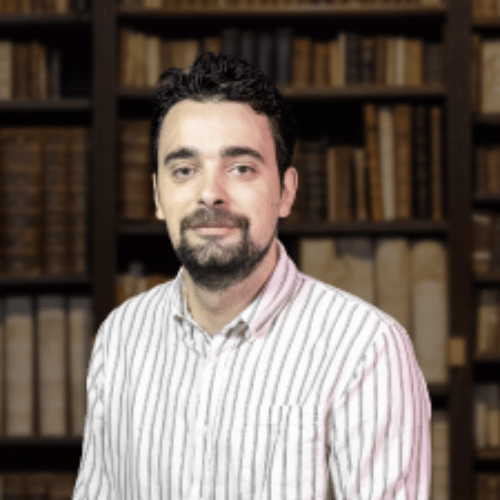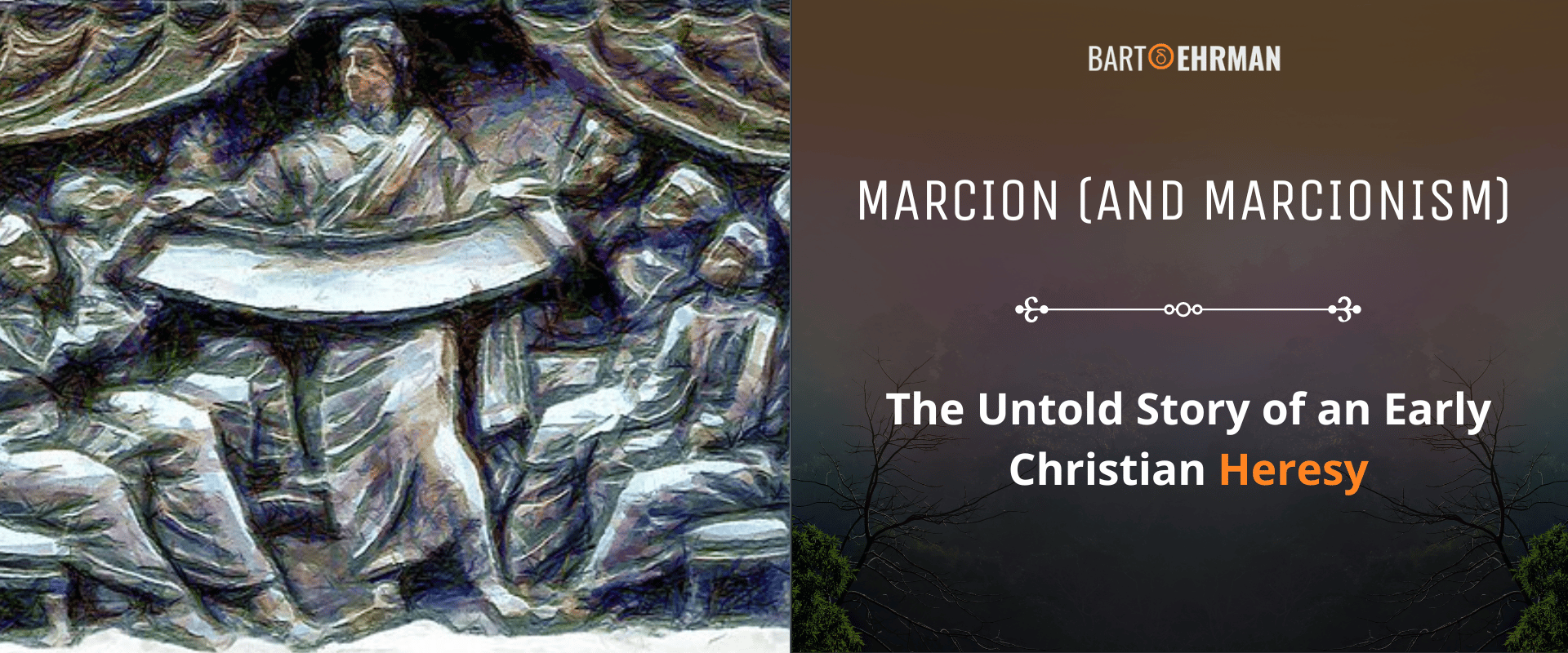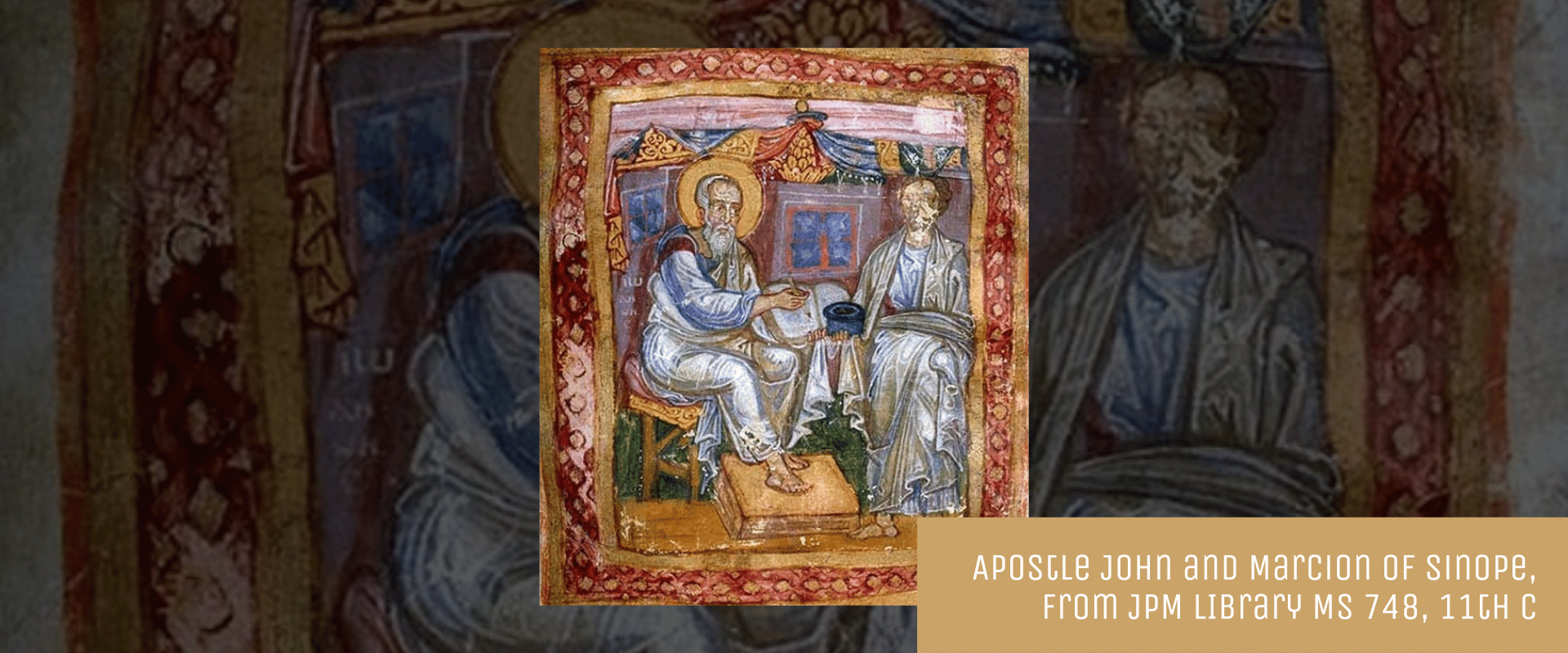Marcion (and Marcionism): The Untold Story of an Early Christian Heresy

Written by Marko Marina, Ph.D.
Author | Historian | BE Contributor
Verified! See our guidelines
Verified! See our editorial guidelines
Date written: June 27th, 2024
Disclaimer: The views and opinions expressed in this article belong to the author and do not necessarily match my own. - Dr. Bart D. Ehrman
A couple of years ago, I had a fascinating conversation with a friend about the existence of God. She was a graduate student majoring in psychology, and as we tackled the age-old debate, she argued against the existence of the Biblical God. Her main point?
The stark and often inconceivable differences between the Old and New Testament deities. She noted that these two couldn’t possibly be the same God, thus concluding that belief in a Biblical God was too vague to uphold on rational grounds.
Her argument made me chuckle because I knew that nearly 2,000 years ago, a Christian theologian named Marcion made the very same argument. He, too, pointed out the existence of two separate deities in the Judeo-Christian tradition.
In this article, we’ll explore the life and teachings of Marcion, a significant yet often overlooked figure in early Christian history. We’ll learn about his radical views and how the controversy they sparked played a crucial role in shaping what we now consider “orthodox” or “mainstream” Christianity.
Understanding Marcion’s perspective not only provides insight into the diverse landscape of early Christian thought but also highlights the ongoing debates about the nature of God that continue to this day.
So, who was Marcion, and why did his teachings provoke such a strong reaction from the early Church? In the following sections, we’ll delve into his life, his views on the Old and New Testament gods, and the canon he proposed. We’ll also examine the fierce opposition he faced from prominent Church figures like Irenaeus, Justin Martyr, and Tertullian.
Stay with us as we journey back in time to meet the man who dared to challenge the very foundations of Christian belief. And who knows? You might just find that ancient theological debates are more relevant — and more entertaining — than you ever imagined.

Christianity’s Varied Landscape: A Look at the 2nd and 3rd Centuries
Recently, I discovered that Jehovah's Witnesses also identify as Christians. This places them among more than 45,000 Christian denominations worldwide. But this diversity isn't a modern phenomenon.
Christianity has always encompassed a wide variety of beliefs. From differing views on God to contrasting understandings of Jesus and his resurrection, Christians have never been a monolithic group.
Some Christians think of God as a personal being, almost like a superhuman residing in the sky. Others find it blasphemous to make God in our image and instead view God as an impersonal force behind all life in the universe.
Even the resurrection sparks diverse interpretations: some see it as a literal, physical reanimation of Jesus’ corpse, while others consider it a symbolic claim. So, despite common perceptions, Christianity has always been varied in its beliefs and practices.
This diversity was particularly pronounced in the first few centuries of Christianity. As Bart D. Ehrman notes in his bestseller Lost Christianities:
“In the second and third centuries, there were Christians who believed that God had created the world. But others believed that this world had been created by a subordinate, ignorant divinity... Yet other Christians thought it was worse than that, that this world was a cosmic mistake created by a malevolent divinity... In the second and third centuries, there were Christians who believed that Jesus was both divine and human, God and man. There were other Christians who argued that he was completely divine and not human at all.”
(Affiliate Disclaimer: We may earn commissions on products you purchase through this page at no additional cost to you. Thank you for supporting our site!)
Additionally, during this period, the “proto-orthodox” Church began to emerge, slowly but steadily. This (scholarly) term refers to the group of Christians whose views would later be recognized as the "right" beliefs, especially during the 4th and 5th centuries. As this stream of Christianity gained dominance, it marginalized other groups by labeling them heretical.
In his excellent study Found Christianities, M. David Litwa explains: “Anti-heresy writers made their attacks to avoid being grouped with those whom they considered being politically dangerous subalterns. By the second century CE, Greek and Roman authors tended to use the general descriptor 'Christian' for Christ-believers, whereas Christian insiders used a wide variety of differentiating labels to distinguish their movements from putatively false forms of the faith.”
Today, scholars recognize the polemical attitude of early heresiologists such as Irenaeus. Consequently, they view the Christian world as including all the figures and movements that claimed the name “Christian” for themselves. This broader understanding helps us appreciate the rich tapestry of early Christian thought and the intense debates that shaped it.
It’s within this diverse and dynamic context that Marcion emerged. Understanding it allows us to fully grasp his revolutionary ideas and the profound impact they had on Christianity’s development.
And who knows? Maybe, next time you hear a modern debate about the nature of Biblical God you’ll also smile, knowing that such discussions have been around for nearly two millennia. So, who was Marcion? What did he teach? Let’s take a closer look!
Who Was Marcion?: A Brief Look at an Amazing Life
Marcion was raised in a Christian church in Sinope, in northern Asia Minor (modern-day Turkey). His father was allegedly the bishop of the church, a role that imbued Marcion with early exposure to Christian teachings.
However, this upbringing also led to conflict. His father eventually deemed Marcion’s views too heretical to tolerate — a foreshadowing of the larger controversies to come.
As a (probable) shipowner (Greek: “naukleros”), Marcion was independently wealthy, which afforded him significant influence. He moved to Rome around 139 C.E. and made a substantial donation to the church — reportedly 200,000 sesterces.
In his book From Paul to Valentinus, Peter Lampe highlights the significance of Marcion's occupation: “A 'naukleros' is a shipowner or a captain of his own or a rented ship with which he conducts business in his name. The extreme risk of overseas trade not only presupposes capital but also yields profit. Numerous bequests and donations of considerable size made by 'naukleroi' testify that their occupation is lucrative.”
Undoubtedly, Marcion’s wealth and status provided him with the means and platform to propagate his beliefs.
In Rome, Marcion devoted himself to studying and writing, producing two significant literary works that would later define Marcionism. In 144 A.D., he called a council of the church leaders in Rome, marking the first known church council meeting. He hoped the leaders would ratify his views, but instead, the Roman church elders found his ideas repugnant.
They excommunicated him from the church and returned his generous donation. Undeterred, Marcion left Rome and traveled through Asia Minor, establishing Marcionite churches and gaining a substantial following.
Marcion's teachings proved remarkably successful, despite the strong opposition from the proto-orthodox Church. He continued to spread his doctrine until his death around 160 C.E., just before the reign of Marcus Aurelius (161-180). His impact on early Christianity was profound, and Marcionite Christian church establishments persisted for several centuries.
But the history of Marcionism is only the beginning. What characterized Marcion were his radical teachings that shook the foundations of the early “proto-orthodox” Church. Let’s delve into the Marcion beliefs that made him one of the most controversial figures in Christian history.
FREE COURSE!
WHY I AM NOT A CHRISTIAN
Raw, honest, and enlightening. Bart's story of why he deconverted from the Christian faith.
Over 6,000 enrolled!
Marcion’s Teachings: A Challenge to the Proto-Orthodox Church
Marcion's admiration for Paul stood in stark contrast to the views of other early Christian groups such as the Ebionites, who saw Paul as their mortal enemy. Marcion believed Paul was the only apostle who truly understood the nature of Jesus' message.
In his letters, Paul emphasized that Jesus' crucifixion and resurrection brought salvation to the world. Paul also made a clear distinction between his gospel message and the Jewish law, asserting that people are made right with God through faith in the resurrected Christ, not by following the Mosaic Law. Marcion took this differentiation to its logical extreme.
For Marcion, there was a radical disjunction between the Old Testament law and the "good news" that Jesus brought. He argued that the God who gave the gospel couldn’t be the same God who gave the law.
According to Marcion, the law was given to the Jews by their own God, whereas the gospel was given by Jesus, who came from a different, higher God. This led Marcion to conclude that the God of Jesus wasn’t the God of the Jews.
He saw the Jewish God as the creator of this world, who called Israel to be his people and gave them his law. Since they couldn’t keep this law, they were condemned by the wrathful justice of their God.
In contrast, Marcion believed that the God of Jesus was a God of mercy and love. Jeffrey S. Siker summarizes Marcion's main teachings:
“Marcion was convinced that the good and loving God revealed in Jesus Christ was different from the vindictive God of the Jews who created and ruled this world. The inferior God of the Jews, to whom Jewish scriptures testify, is a jealous and vengeful God who requires sacrifices, commands the slaughter of entire peoples, and is inconsistent. Marcion argued that the loving God of Jesus is essentially antithetical to the God of the Jewish scriptures.”
Moreover, Marcion asserted that Jesus came to save people from the just wrath of the Old Testament God who created this world. Consequently, Marcion concluded that Jesus wasn’t born into this world or part of it. Instead, he viewed Jesus as a phantasm, an apparition who appeared in the world but wasn’t of the world.
This belief further underscored Marcion's radical departure from the emerging orthodoxy that emphasized both the human and divine nature of Jesus.
Marcion's views presented a profound challenge to the early “proto-orthodox” Church. By distinguishing between the God of the Old Testament and the God of the New Testament, he introduced a form of dualism that starkly contrasted with emerging orthodox beliefs.
But that wasn't the whole story. Marcion even went so far as to create his version of the Christian canon, which would become a cornerstone of his teachings and further ignite debates within the early Church.
Marcion’s Canon
Marcion developed his views through two major literary productions: one he wrote himself and another that he edited. His original work, the “Antitheses”, presented a series of contradictory statements highlighting the differences between the Old Testament God of wrath and the God of love and mercy revealed by Jesus.
For instance, the Old Testament God commanded the Israelites to annihilate their enemies in Jericho (Joshua 6), whereas Jesus' God instructed his followers to love their enemies (Matthew 5:44). The Old Testament God permitted the prophet Elisha to summon bears to attack children who taunted him (2 Kings 2:23-24), but Jesus welcomed children, saying, “Let the little children come to me” (Matthew 19:14).
In his “Antitheses”, Marcion aimed to demonstrate that “above all was the Supreme God, the Father of Jesus Christ and the Lord of the Gospel; infinitely below him in degree and attributes was the Creator of this world whose law was death and whose justice blinded men to the truth of the gospel”, as Joseph Hoffman notes in his book Marcion: On the Restitution of Christianity.
Marcion’s other major contribution was his edited work, which was the first known canon of Scripture devised by an early Christian.
This canon contained eleven books: ten of Paul’s letters (all that are now found in the New Testament, except 1 and 2 Timothy and Titus) and a gospel very much like our Gospel of Luke. The Old Testament wasn’t excluded from his canon.
Reflecting on the historical significance of Marcion's decision, Jean Daniélou remarks in L'Eglise des premiers temps:
“He was the first, with the apologist Tatian, to pose the problem of writing and finalizing the New Testament. What were the authentic texts attesting to the preaching of Jesus? Was it necessary to take the novelty of the Gospel to its limits by eliminating its roots?... He completely de-Judaized the historical character of Jesus.” (my translation)
However, even the books Marcion included in his canon made references to the God of the Old Testament and contained positive comments about creation. Marcion argued that these texts had been corrupted by Judaizers, who inserted such references.
Consequently, Marcion removed any passages he believed contradicted the gospel he thought he inherited from Paul. This included, for example, the first two chapters of Luke, which narrate Jesus’ birth in fulfillment of the Jewish Scriptures.
By setting forth a distinct set of scriptures, Marcion not only challenged the emerging orthodoxy but forced the early Church to grapple with which texts genuinely represented the Christian faith. This act of defining a canon was a critical step in the development of the New Testament as we know it today.

The Proto-Orthodox Church Strikes Back: Response to Marcion
Writing in the middle of the 2nd century, Justin Martyr observed:
“Then a certain Marcion of Pontus, who is even now teaching those who are persuaded to acknowledge another God greater than the creator. In every race of humanity through the agency of demons, he has caused many to utter blasphemies and to deny the maker of all as God and to confess some other as being greater to have made greater things than him.”
This early polemical attack on Marcion highlights the intense opposition he faced from the proto-orthodox Church.
Judith Lieu, in her book Marcion and the Making of a Heretic, comments on Justin's depiction: “Already in this, the earliest reference to Marcion, he is being ‘mythologised’ — reconstructed to serve the interests of his portrayer, on whose description any subsequent account must rely.”
There is no doubt: Early proto-orthodox authors and bishops heavily criticized Marcion, labeling his teachings as heretical. Eric Osborn notes that “no one stirred up more trouble in the early Church than Marcion when he divided the just inferior Jewish creator from the good Christian God of love.”
In the early 3rd century, Tertullian dedicated a five-volume work, Against Marcion, to discredit Marcion's teachings and diminish his influence within early Christianity. Tertullian systematically refuted Marcion's arguments, demonstrating that even the New Testament texts Marcion retained (Luke’s Gospel and the Pauline epistles) are incomprehensible without considering their Jewish background.
Furthermore, Tertullian argued that Christ is the creator, whose incarnation was predicted by the Old Testament prophets. He did all of that while basing his refutation solely on the texts Marcion accepted as canonical.
Ultimately, the proto-orthodox Church triumphed, and Marcion, along with other groups labeled as heretical, was marginalized. The reasons for the proto-orthodox Church's success are numerous. In Lost Christianities, Bart Ehrman outlines some key factors:
From my standpoint, this hierarchical structure was the main reason for the triumph of proto-orthodoxy. Paul Veyne, in Quand notre monde est devenu chrétien?, describes the Church's hierarchy and organization as "formidable machinery which, little by little, supervised and Christianized the mass of the population and even sent missionaries among foreign peoples.” (my translation)
These strategic advantages allowed the proto-orthodox Church to consolidate its position and eventually dominate the diverse landscape of early Christianity. In the end, Marcionites were delegated to the fringes of Christian history. Is history written by the winners? In this case, it’s not far-fetched to answer affirmingly.
Conclusion
Marcion's beliefs and his daring theological innovations left a significant mark on early Christian history. By presenting a radical distinction between the Old Testament God of justice and wrath and the New Testament God of mercy and love, Marcion forced the early Church to confront and clarify its doctrines.
His establishment of the first known Christian canon, though eventually deemed heretical, prompted the early Church to define and solidify the New Testament canon that is recognized today.
Despite the fierce opposition he faced from early Church figures such as Polycarp, Justin Martyr, and Tertullian, and the eventual marginalization of his followers, Marcion's legacy endures. His controversial views sparked crucial debates about the nature of God, the interpretation of Scripture, and the essence of Christian religion.
Marcion’s influence, while ultimately subdued by the proto-orthodox Church's strategic organizational strength and doctrinal consolidation, played a pivotal role in shaping the theological and structural foundations of mainstream Christianity.
For a deeper exploration of early Christian figures and their theological divergences, check out Dr. Bart D. Ehrman's online course, “Paul and Jesus: The Great Divide”. In it, Dr. Ehrman discovered fascinating differences between these two figures, thus enabling us to understand more deeply the complexities that lie behind the origins of Christianity.
FREE COURSE!
WHY I AM NOT A CHRISTIAN
Raw, honest, and enlightening. Bart's story of why he deconverted from the Christian faith.
Over 6,000 enrolled!
